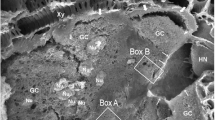Summary
The plant pathogenic nematodeMeloidogyne incognita forms conspicuous tubular structures referred to as feeding tubes in special food cells, called giant-cells, induced and maintained in susceptible host roots by feeding nematodes. Feeding tubes are formed by nematode secretions injected into giant-cells via a stylet and apparently function to facilitate withdrawal of soluble assimilates by the parasite. In giant-cells in roots of the four host species examined in this study, feeding tube morphology was identical. Tubes were straight to slightly curved structures just less than 1 μm wide and up to slightly more than 70 μm long. At the ultrastructural level, each tube consisted of a 190–290 nm thick, electron-dense, crystalline wall surrounding an electron-transparent lumen with a diameter of 340–510 nm. The distal end of the tube was sealed with wall material. Older tubes were found free in the host cytoplasm while the proximal ends of young tubes were attached to the host cell wall via short wall ingrowths through which the nematode's stylet was inserted. An elaborate membrane system was associated with the feeding tubes and was most extensive around newly formed tubes. Contiguous to the feeding tube wall, this membrane system consisted of strands of smooth endoplasmic reticulum while rough endoplasmic reticulum predominated toward the outer margin of the membrane system. Vacuoles and mitochondria were excluded from a zone of cytoplasm surrounding feeding tubes. This zone of exclusion, as well as the membrane system noted above, tended to be less pronounced or absent around older tubes no longer being used by the nematode.
Similar content being viewed by others
References
Bird AF, Loveys BR (1975) The incorporation of photosynthates byMeloidogyne javanica. J Nematol 7: 111–113
Chrispeels MJ (1980) The endoplasmic reticulum. In: Tolbert NE (ed) The biochemistry of plants, vol 1, the plant cell. Academic Press, New York, pp 390–412
Endo BY (1978) Feeding plug formation in soybean roots infected with the soybean cyst nematode. Phytopathology 68: 1022–1031
— (1987) Ultrastructure of esophageal gland secretory granules in juveniles ofHeterodera glycines. J Nematol 19: 469–483
Harris N (1986) Organization of endomembrane systems. Annu Rev Plant Physiol 37: 73–92
Huang CS (1985) Formation, anatomy, and physiology of giant cells induced by root-knot nematodes. In: Sasser JN, Carter CC (eds) An advanced treatise onMeloidogyne, vol 1, biology and control. North Carolina State University Graphics, Raleigh, NC, pp 115–164
Huettel RN, Rebois RV (1985) Culturing plant parasitic nematodes using root explants. In: Zuckerman BM, Mai WF, Harrison (eds) Plant nematology laboratory manual. Univ Mass Agricult Exp Stat Amherst, MA, pp 155–158
Hussey RS (1989) Disease-inducing secretions of plant-parasitic nematodes. Annu Rev Phytopathol 27: 123–141
— (1985) Host-parasite relationships and associated physiological changes. In: Sasser JN, Carter CC (eds) An advanced treatise onMeloidogyne, vol 1, biology and control. North Carolina State University Graphics, Raleigh, NC, pp 143–153
— Barker KR (1973) A comparison of methods of collecting inocula ofMeloidogyne spp., including a new technique. Plant Dis Rep 57: 1025–1028
— Mims CW (1990) Ultrastructure of esophageal glands and their secretory granules in the root-knot nematodeMeloidogyne incognita. Protoplasma 156: 9–18
— Paguio OR, Seabury F (1990) Localization and purification of a secretory protein from the esophageal glands ofMeloidogyne incognita with a monoclonal antibody. Phytopathology 80: 809–714
Jones MGK (1981) Host cell responses to endoparasitic nematode attack: structure and function of giant cells and syncytia. Ann Appl Biol 97: 353–372
Jones RK (1978) Histological and ultrastructural changes in cereal roots caused by feeding ofHelicotylenchus spp. Nematologica 24: 393–397
McClure MA (1977)Meloidogyne incognita: a metabolic sink. J Nematol 9: 88–90
Mims CW, Richardson EA, Taylor J (1988) Specimen orientation for transmission electron microscopic studies of fungal germ tubes and appressoria on artificial membranes and leaf surfaces. Mycologia 80: 586–590
Muller M, Moor H (1984) Cryofixation of thick specimens by high pressure freezing. In: Revel J-P, Barnard T, Gaggis HG (eds) The science of biological specimen preparation for microscopy and microanalysis. Proceedings 2nd Pfefferkorn Conference. AMF O'Hare, Chicago, IL, pp 121–128
Nemec B (1911) Über die Nematodenkrankheiten der Zuckerrübe. Z Pflanzen 21: 1–10
Pate JS, Gunning ES (1972) Transfer cells. Annu Rev Plant Physiol 23: 173–196
Paulson RE, Webster JM (1970) Giant cell formation in tomato roots caused byMeloidogyne incognita andMeloidogyne hapla (Nematoda)_infection. A light and electron microscopy study. Can J Bot 48: 271–276
Razak AR, Evans AAF (1976) An intracellular tube associated with feeding byRotylenchulus reniformis on cowpea root. Nematologica 22: 182–189
Rebois RV (1980) Ultrastructure of a feeding peg and tube associated withRotylenchulus reniformis in cotton. Nematologica 26: 396–405
Ruppenhorst HJ (1984) Intracellular feeding tubes associated with sedentary plant parasitic nematodes. Nematologica 30: 77–85
Sasser JN (1980) Root-knot nematodes: a global menace to crop production. Plant Dis 64: 36–41
Schuerger AC, McClure MA (1983) Ultrastructural changes induced byScutellonema brachyurum in potato roots. Phytopathology 73: 70–81
Wiggers RJ, Starr JL, Price HJ (1990) DNA content and variation in chromosome number in plant cells affected by the parasitic nematodesMeloidogyne incognita andM. arenaria. Phytopathology 80: 1391–1395
Wyss U, Zunke U (1986) Observations on the behaviour of second-stage juveniles ofHeterodera schachtii inside host roots. Rev Nematol 9: 153–165
—, Stender C, Lehmann H (1984) Ultrastructure of feeding sites of the cyst nematodeHeterodera schachtii Schmidt in roots of susceptible and resistantRaphanus sativus L. var.oleiformis cultivars. Physiol Plant Pathol 25: 21–37
Author information
Authors and Affiliations
Rights and permissions
About this article
Cite this article
Hussey, R.S., Mims, C.W. Ultrastructure of feeding tubes formed in giant-cells induced in plants by the root-knot nematodeMeloidogyne incognita . Protoplasma 162, 99–107 (1991). https://doi.org/10.1007/BF02562553
Received:
Accepted:
Issue Date:
DOI: https://doi.org/10.1007/BF02562553




